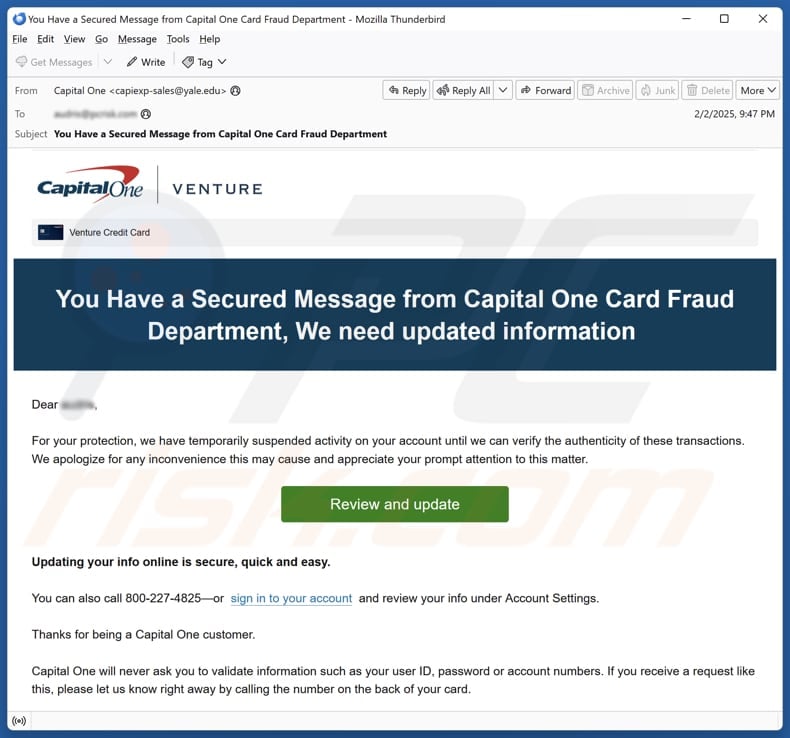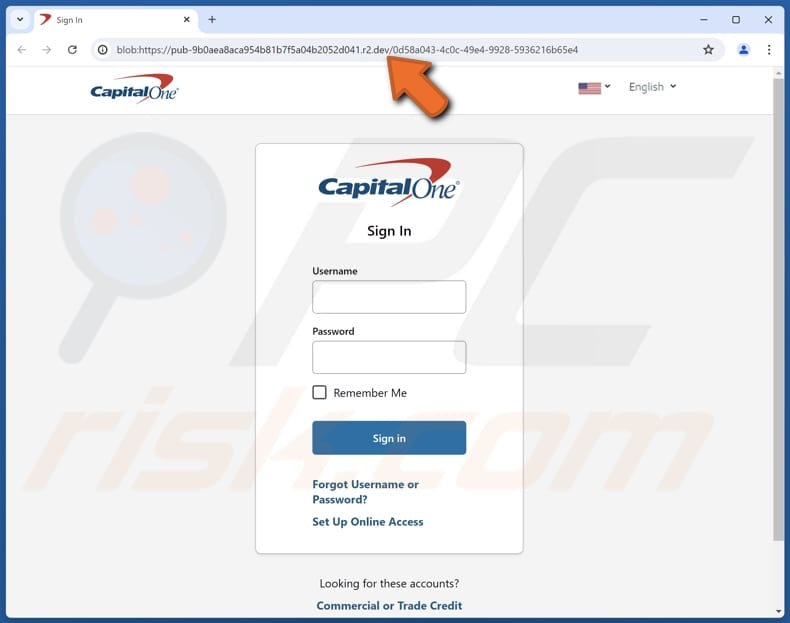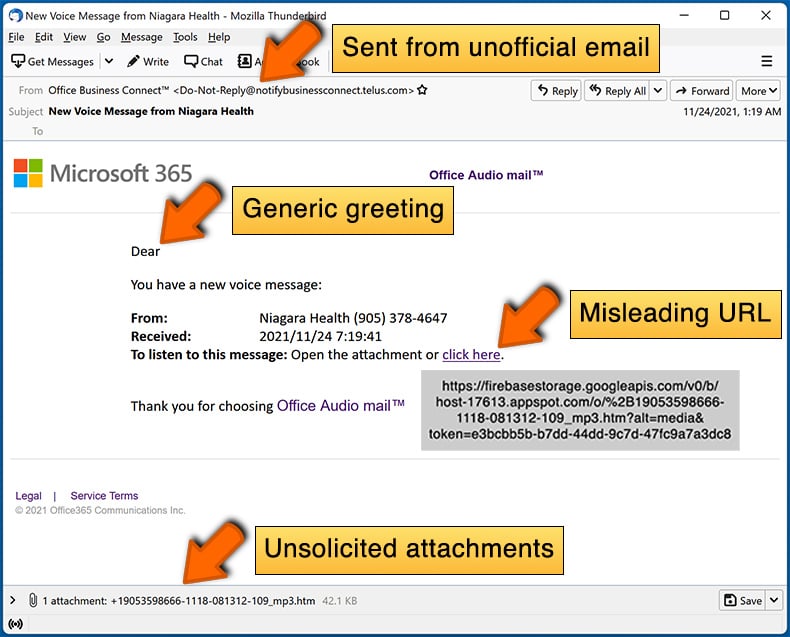How to identify scams like the fake "Capital One - Secured Message" email
Phishing/ScamAlso Known As: Capital One - Secured Message phishing email
Get free scan and check if your device is infected.
Remove it nowTo use full-featured product, you have to purchase a license for Combo Cleaner. Seven days free trial available. Combo Cleaner is owned and operated by RCS LT, the parent company of PCRisk.com.
What is "Capital One - Secured Message"?
We have analyzed the email and concluded that it is a scam (a phishing email). The scammers behind it aim to trick recipients into believing that this is a notification from Capital One (a legitimate bank) regarding a received security message. The purpose of this scam email is to steal personal information.

More about the "Capital One - Secured Message" scam email
This phishing email is created to deceive the recipient into updating their personal information. It claims that suspicious transactions have caused the temporary suspension of the account and urges the user to verify their details to restore access. The email contains a link ("Review and update" button) for the recipient to click on.
This link leads to a fake Capital One website designed to steal login credentials (username and password). With stolen Capital One account usernames and passwords, scammers can gain access to the victim's account and potentially steal sensitive financial information. They may also be able to make unauthorized transactions.
Moreover, scammers can try to use stolen usernames and passwords to access other accounts. They often use the same login details on different sites, hoping victims reuse passwords. If they succeed, they could gain access to email, social media, or other accounts and use them for malicious purposes (e.g., to send phishing emails, deliver malware, or extract more personal information).
Additionally, scammers may sell stolen login credentials and information obtained from accessed accounts on the dark web. Thus, recipients are advised to avoid clicking any links or responding to the email, as doing so could lead to financial losses, identity theft, and other issues.
| Name | Capital One - Secured Message Email Scam |
| Threat Type | Phishing, Scam, Social Engineering, Fraud |
| Fake Claim | Capital One account has been temporarily suspended |
| Disguise | Notification from Capital One |
| Symptoms | Generic greeting, urgent language, suspicious links, grammatical errors. |
| Distribution methods | Deceptive emails, rogue online pop-up ads, search engine poisoning techniques, misspelled domains. |
| Damage | Loss of sensitive private information, monetary loss, identity theft. |
| Malware Removal (Windows) |
To eliminate possible malware infections, scan your computer with legitimate antivirus software. Our security researchers recommend using Combo Cleaner. Download Combo CleanerTo use full-featured product, you have to purchase a license for Combo Cleaner. 7 days free trial available. Combo Cleaner is owned and operated by RCS LT, the parent company of PCRisk.com. |
Similar scam emails in general
Phishing emails are a common tactic used by scammers to steal personal information. Typically, fraudsters seek to steal login credentials, credit card details, ID card information, or other details. They often pretend to be legitimate companies or organizations to deceive recipients.
It is important to stay alert and avoid opening suspicious links or responding to questionable emails, as these actions can lead to financial losses, data theft, and other issues, and potentially infect computers with malware. Examples of fraudulent email scams are "Update Your Microsoft Account Settings", "Capital One - Card Purchase Is Under Review", and "Update Your Webmail Account Settings".
How do spam campaigns infect computers?
Cybercriminals use emails to distribute malware by attaching infected files or embedding malicious links. Opening these files or enabling certain features, such as macros in MS Office documents, can trigger malware execution. Attackers may also use other file types, including PDFs, executables, ISO files, scripts, and compressed archives.
Deceptive emails can also redirect users to fake websites that can initiate automatic malware downloads or trick users into manually downloading and installing malicious software. Ultimately, these attacks rely on tricking users into actions that lead to malware infections.
How to avoid installation of malware?
Be careful with unsolicited or irrelevant emails from unknown senders, especially those containing attachments or links. Avoid interacting with such messages (opening their contents). Always download software from official websites or trusted app stores. Other sources can be used to distribute unwanted and malicious software.
Furthermore, avoid clicking pop-ups, buttons, or links encountered on shady websites. Keep your operating system and installed software up to date. Additionally, scan your computer for threats using a reliable security tool on a regular basis. If you have already opened malicious attachments, we recommend running a scan with Combo Cleaner Antivirus for Windows to automatically eliminate infiltrated malware.
Text presented in the "Capital One - Secured Message" email letter:
Subject: You Have a Secured Message from Capital One Card Fraud Department
Capital One | VentureYou Have a Secured Message from Capital One Card Fraud Department, We need updated information
Dear ******,
For your protection, we have temporarily suspended activity on your account until we can verify the authenticity of these transactions. We apologize for any inconvenience this may cause and appreciate your prompt attention to this matter.
Review and update
Updating your info online is secure, quick and easy.You can also call 800-227-4825—or sign in to your account and review your info under Account Settings.
Thanks for being a Capital One customer.
Capital One will never ask you to validate information such as your user ID, password or account numbers. If you receive a request like this, please let us know right away by calling the number on the back of your card.
Fake Capital One page used in this scam:

Instant automatic malware removal:
Manual threat removal might be a lengthy and complicated process that requires advanced IT skills. Combo Cleaner is a professional automatic malware removal tool that is recommended to get rid of malware. Download it by clicking the button below:
DOWNLOAD Combo CleanerBy downloading any software listed on this website you agree to our Privacy Policy and Terms of Use. To use full-featured product, you have to purchase a license for Combo Cleaner. 7 days free trial available. Combo Cleaner is owned and operated by RCS LT, the parent company of PCRisk.com.
Quick menu:
- What is Capital One - Secured Message phishing email?
- Types of malicious emails.
- How to spot a malicious email?
- What to do if you fell for an email scam?
Types of malicious emails:
![]() Phishing Emails
Phishing Emails
Most commonly, cybercriminals use deceptive emails to trick Internet users into giving away their sensitive private information, for example, login information for various online services, email accounts, or online banking information.
Such attacks are called phishing. In a phishing attack, cybercriminals usually send an email message with some popular service logo (for example, Microsoft, DHL, Amazon, Netflix), create urgency (wrong shipping address, expired password, etc.), and place a link which they hope their potential victims will click on.
After clicking the link presented in such email message, victims are redirected to a fake website that looks identical or extremely similar to the original one. Victims are then asked to enter their password, credit card details, or some other information that gets stolen by cybercriminals.
![]() Emails with Malicious Attachments
Emails with Malicious Attachments
Another popular attack vector is email spam with malicious attachments that infect users' computers with malware. Malicious attachments usually carry trojans that are capable of stealing passwords, banking information, and other sensitive information.
In such attacks, cybercriminals' main goal is to trick their potential victims into opening an infected email attachment. To achieve this goal, email messages usually talk about recently received invoices, faxes, or voice messages.
If a potential victim falls for the lure and opens the attachment, their computers get infected, and cybercriminals can collect a lot of sensitive information.
While it's a more complicated method to steal personal information (spam filters and antivirus programs usually detect such attempts), if successful, cybercriminals can get a much wider array of data and can collect information for a long period of time.
![]() Sextortion Emails
Sextortion Emails
This is a type of phishing. In this case, users receive an email claiming that a cybercriminal could access the webcam of the potential victim and has a video recording of one's masturbation.
To get rid of the video, victims are asked to pay a ransom (usually using Bitcoin or another cryptocurrency). Nevertheless, all of these claims are false - users who receive such emails should ignore and delete them.
How to spot a malicious email?
While cyber criminals try to make their lure emails look trustworthy, here are some things that you should look for when trying to spot a phishing email:
- Check the sender's ("from") email address: Hover your mouse over the "from" address and check if it's legitimate. For example, if you received an email from Microsoft, be sure to check if the email address is @microsoft.com and not something suspicious like @m1crosoft.com, @microsfot.com, @account-security-noreply.com, etc.
- Check for generic greetings: If the greeting in the email is "Dear user", "Dear @youremail.com", "Dear valued customer", this should raise suspiciousness. Most commonly, companies call you by your name. Lack of this information could signal a phishing attempt.
- Check the links in the email: Hover your mouse over the link presented in the email, if the link that appears seems suspicious, don't click it. For example, if you received an email from Microsoft and the link in the email shows that it will go to firebasestorage.googleapis.com/v0... you shouldn't trust it. It's best not to click any links in the emails but to visit the company website that sent you the email in the first place.
- Don't blindly trust email attachments: Most commonly, legitimate companies will ask you to log in to their website and to view any documents there; if you received an email with an attachment, it's a good idea to scan it with an antivirus application. Infected email attachments are a common attack vector used by cybercriminals.
To minimise the risk of opening phishing and malicious emails we recommend using Combo Cleaner Antivirus for Windows.
Example of a spam email:

What to do if you fell for an email scam?
- If you clicked on a link in a phishing email and entered your password - be sure to change your password as soon as possible. Usually, cybercriminals collect stolen credentials and then sell them to other groups that use them for malicious purposes. If you change your password in a timely manner, there's a chance that criminals won't have enough time to do any damage.
- If you entered your credit card information - contact your bank as soon as possible and explain the situation. There's a good chance that you will need to cancel your compromised credit card and get a new one.
- If you see any signs of identity theft - you should immediately contact the Federal Trade Commission. This institution will collect information about your situation and create a personal recovery plan.
- If you opened a malicious attachment - your computer is probably infected, you should scan it with a reputable antivirus application. For this purpose, we recommend using Combo Cleaner Antivirus for Windows.
- Help other Internet users - report phishing emails to Anti-Phishing Working Group, FBI’s Internet Crime Complaint Center, National Fraud Information Center and U.S. Department of Justice.
Frequently Asked Questions (FAQ)
Why did I receive this email?
Scammers often send out these messages without personalizing them for specific individuals. They collect email addresses from publicly available sources, data breaches, or fake sites and try to reach as many people as possible.
I have provided my personal information when tricked by this email, what should I do?
If you’ve given out personal information, make sure to update your passwords as soon as possible. Additionally, contact the relevant service(s) (e.g., your bank) to report the incident.
I have downloaded and opened a malicious file attached to this email, is my computer infected?
It depends on the type of file opened. If it was an executable, the system is likely compromised. However, if it was a document file, the risk of infection is lower, though it still depends on whether macros were enabled or other actions were taken
I have read the email but did not open the attachment, is my computer infected?
Simply opening an email is usually safe, but clicking links or opening attachments can put your device at risk of malware.
Will Combo Cleaner remove malware infections that were present in email attachment?
Combo Cleaner can detect and remove most known malware, but some advanced threats might be concealed in your system. For thorough removal, it is best to perform a full system scan.
Share:

Tomas Meskauskas
Expert security researcher, professional malware analyst
I am passionate about computer security and technology. I have an experience of over 10 years working in various companies related to computer technical issue solving and Internet security. I have been working as an author and editor for pcrisk.com since 2010. Follow me on Twitter and LinkedIn to stay informed about the latest online security threats.
PCrisk security portal is brought by a company RCS LT.
Joined forces of security researchers help educate computer users about the latest online security threats. More information about the company RCS LT.
Our malware removal guides are free. However, if you want to support us you can send us a donation.
DonatePCrisk security portal is brought by a company RCS LT.
Joined forces of security researchers help educate computer users about the latest online security threats. More information about the company RCS LT.
Our malware removal guides are free. However, if you want to support us you can send us a donation.
Donate
▼ Show Discussion